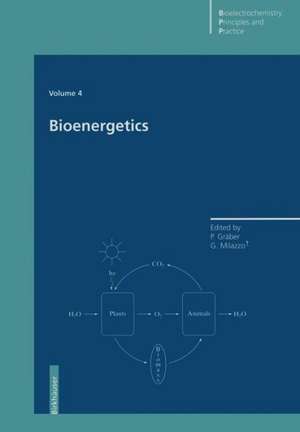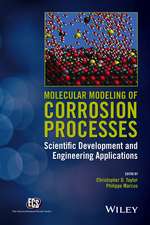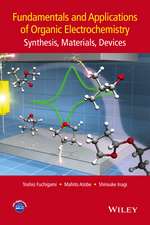Bioenergetics: Bioelectrochemistry: Principles and Practice, cartea 4
Editat de Peter Gräber, Giulio Milazzoen Limba Engleză Paperback – noi 2011
Preț: 657.08 lei
Preț vechi: 773.03 lei
-15% Nou
Puncte Express: 986
Preț estimativ în valută:
125.73€ • 131.02$ • 104.11£
125.73€ • 131.02$ • 104.11£
Carte tipărită la comandă
Livrare economică 03-17 aprilie
Preluare comenzi: 021 569.72.76
Specificații
ISBN-13: 9783034898607
ISBN-10: 3034898606
Pagini: 560
Ilustrații: XIV, 542 p.
Dimensiuni: 170 x 244 x 29 mm
Greutate: 0.88 kg
Ediția:1997
Editura: Birkhäuser Basel
Colecția Birkhäuser
Seria Bioelectrochemistry: Principles and Practice
Locul publicării:Basel, Switzerland
ISBN-10: 3034898606
Pagini: 560
Ilustrații: XIV, 542 p.
Dimensiuni: 170 x 244 x 29 mm
Greutate: 0.88 kg
Ediția:1997
Editura: Birkhäuser Basel
Colecția Birkhäuser
Seria Bioelectrochemistry: Principles and Practice
Locul publicării:Basel, Switzerland
Public țintă
ResearchCuprins
1. Nonequilibrium thermodynamics applied to energy conversion in biological systems.- • Introduction.- • Elements of nonequilibrium thermodynamics.- • Steady states.- • Mechanisms of coupling between processes.- • Phenomenological description of processes and systems.- • Control and regulation of processes.- 2. Global bioenergetics.- • Introduction.- • Thermodynamic principles.- • Thermodynamic efficiencies and global bioenergetics.- • The current steady state: Global cycles of matter associated with global bioenergetics.- • Approach to the current steady state: Evolution of free-enthalpy transducing biosystems.- 3. Vectorial bioenergetics.- • Bioenergetics in a homogeneous compartment.- • Cellular compartmentation and bioenergetics.- • Proton bioenergetics.- • Transport phenomena.- • Sodium bioenergetics.- 4. Energetics of aerobic and anaerobic bacteria.- • Introduction.- • Principles of biological energy transformations.- • Energy-generating processes.- • Energy-requiring processes.- 5. Chloroplasts.- • Introduction.- • Light-driven electron transport and proton translocation.- • Carbon metabolism.- • Other metabolic pathways.- • Transport across the envelope.- • Photoregulation of chloroplast function.- 6. The mammalian mitochondrial respiratory chain.- • Introduction.- • Principles of electron transfer-linked proton translocation.- • NADH: ubiquinone oxidoreductase (complex I).- • Succinate: ubiquinone oxidoreductase (complex II).- • Ubihydroquinone: cytochrome c oxidoreductase (complex III).- • The diffusible redox carriers ubiquinone and cytochrome c.- • Energy balance of electron transfer reactions.- • Carrier proteins involved in energy transduction.- • Interaction of electron transfer chain,ATP synthase, adenine nucleotide carrier, and phosphate carrier, resulting in the coupling of oxidative phosphorylation.- 7. Photosystem II and water oxidation in cyanobacteria, algae and higher plants.- • Introduction.- • Overall organisation of water cleavage in Photosystem II.- • Light absorption and transformation into electrochemical free energy in Photosystem II.- • Water oxidation.- • Plastoquinone reduction.- 8. The photosystem I reaction center in oxygenic photosynthesis.- • Introduction.- • Energy transfer in PS-I.- • Electron transfer in PS-I.- • Polypeptides of the PS-I reaction center.- • Structure of the PS-I reaction center.- • Comparison with green sulfur bacteria and heliobacteria.- 9. The cytochrome b6f/bcl-complexes.- • Introduction.- • Occurrence.- • Components and structure.- • Function.- • Regulation.- 10. Cytochrome c oxidase.- • Introduction.- • Structure.- • Spectroscopy.- • Ligand binding reactions.- • Electron transfer reactions.- • Proton transfer reactions.- • Electrochemistry of the metal centres.- 11. Bacteriorhodopsin.- • Introduction.- • The bacterium.- • Bioenergetics of H. salinarium.- • The bacteriorhodopsin in purple membrane.- • The photocycle.- • Halorhodopsin.- 12. Structure, function and regulation of the H+-ATPases from chloroplasts.- • Introduction.- • Structure of H+-ATPases.- • The catalytic reaction of H-ATPases.- • The regulation of CF0F1.
















